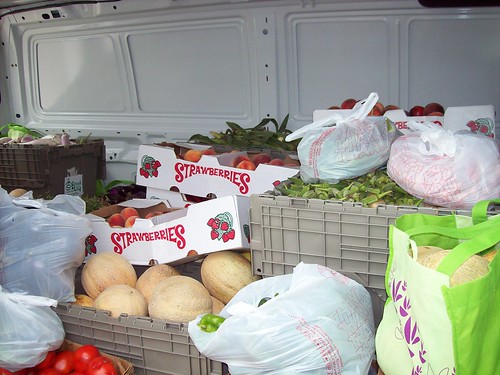
[This week's Glean for the City guest post comes from Susan Birchler, Market Manager at the West End Farmer's Market. Thanks, Susan! ~Jeffrey]
Plant one zucchini plant in your garden and all summer you will have an abundance of zucchini. Even an overabundance. Living things at the lower end of the food chain – apple trees, ants, plankton, etc - tend towards a productiveness that makes for an overabundance of food for things living higher up the food chain. Now, consider the difference between anteaters and woodpeckers. Anteaters find an anthill (or termite mound) and with their sticky, quick tongues they consume around 1000 insects a minute. Woodpeckers eat ants too -- but also grubs, beetles, caterpillars, tree sap, seeds and fruits. They are opportunistic and flexible, pecking the bark and wood of trees, consuming whatever they find. Zoologists refer to animals like the woodpecker as "gleaners." This indicates that they scour the environment to find scattered bits of food. They are nature's way of efficiently utilizing her decentralized abundance.
Now, consider the difference between anteaters and woodpeckers. Anteaters find an anthill (or termite mound) and with their sticky, quick tongues they consume around 1000 insects a minute. Woodpeckers eat ants too -- but also grubs, beetles, caterpillars, tree sap, seeds and fruits. They are opportunistic and flexible, pecking the bark and wood of trees, consuming whatever they find. Zoologists refer to animals like the woodpecker as "gleaners." This indicates that they scour the environment to find scattered bits of food. They are nature's way of efficiently utilizing her decentralized abundance.
Human food systems have been mainly organized to make people behave more like anteaters: channeling vast amounts of foodstuffs through centralized locations, like farms and supermarkets. But that does not mean this system is perfectly efficient - in fact, it leaves considerable waste. Gleaning is an activity often missing from our modern food system. I'm thrilled to see Bread for the City partially correcting that.
Every Sunday, the vendors bring their abundance to the West End Farmers Market. Their fruits and vegetables have been picked the day before, their breads baked early in the morning. When you walk through the market you can smell the earthiness of onions, tomatoes, peaches, only recently separated from the plant it grew on. The farmers are selling freshness. And despite the fact that our market is thriving, there is always some leftover produce.
Yet when the market is over, many vendors don’t have another market for days. Small farmers are usually not equipped with the refrigeration and chemicals necessary to keep leftover produce fresh for two more days; bakers will not sell stale goods. What to do with leftover produce and breads? Plow it into a compost pile? Throw it away? It is a perennial dilemma. It is not as easy as one might imagine to find a willing nonprofit with the necessary organizational machinery to retrieve our surplus abundance. Smaller agencies, hit with economic slump, have closed their doors or are unable to pick up or distribute the foods. So when I read a piece about Bread for the City's Glean for the City project on the Farmers Market Listserve, I hastily emailed an invitation to glean at our market and received an immediate reply.
What to do with leftover produce and breads? Plow it into a compost pile? Throw it away? It is a perennial dilemma. It is not as easy as one might imagine to find a willing nonprofit with the necessary organizational machinery to retrieve our surplus abundance. Smaller agencies, hit with economic slump, have closed their doors or are unable to pick up or distribute the foods. So when I read a piece about Bread for the City's Glean for the City project on the Farmers Market Listserve, I hastily emailed an invitation to glean at our market and received an immediate reply.
The next Sunday Jeffrey Wankel and Heather showed up with a van and bins. Our vendors loaded them down with food. Every week Bread for the City and our vendors engage in a mutually beneficial exchange. The farmers are relieved that their produce will not go to waste; not only that, but it will go to feed those who could not otherwise afford it. The farmers and bakers are so enamored of the process, they sometimes bring extra food specifically to give Jeffrey and Heather.
As market managers, Julie Bryant and I feel like our universe is in harmony. We fulfill our agenda to provide fresh food to the community of consumers. Bread for the City fulfills their agenda to provide nutritious fresh food to a community of people who are not able to access our market. Our collaboration creates a human food system that efficiently utilizes the abundance of grown food by distributing it across a spectrum of the population. We are lucky to have found each other.
[We need an able-bodied volunteer with a large automobile (preferably a truck, SUV, or minivan, but this could be flexible) and about an hour of your time on Tuesday evenings at 6pm. Your work will help us feed dozens of hungry families each week. Please contact me for more details.]
August 17, 2009
Glean for the City: Reaping Abundance
Subscribe to:
Post Comments (Atom)





No comments:
Post a Comment